Research on the Spatial Differences and Network Structure of Economic Development in the Yangtze River Belt, China
Abstract
:1. Introduction
2. Materials and Methods
2.1. Study Area and Data Sources
2.2. Standard Deviation
2.3. Theil Index
2.4. Spatial Autocorrelation
2.5. Modified Gravitation Model
3. Results
3.1. The Yangtze River Economic Belt
3.2. Three Major Regions
3.3. 11 Provinces
3.4. 110 Cities
4. Discussion
4.1. Research Perspective
4.2. Scale Characteristics
4.3. Future Development
5. Conclusions
- (1)
- From 1999 to 2018, the Yangtze River economic belt’s overall GDP exhibited a consistent annual growth trend. While the relative gaps are more stable, the absolute regional economic differences typically show a trend toward growing;
- (2)
- Although the order of the three major areas’ overall economic volume and share is eastern region > central region > western region, the growth rate and share trend is really the exact opposite. The process of initially increasing and then diminishing has been observed in the intergroup differences in the total GDP. The central region has the smallest variation in total GDP, while the western region has the largest;
- (3)
- There is an increasing trend in the absolute differences in the total GDP of the 11 provinces, with the trend increasing from west to east. The 11 provinces’ combined GDP exhibits positive global autocorrelation and clear local spatial autocorrelation, but it has little effect on the surrounding areas due to radiation. The 11 provinces’ economic network is monocentric, with a focus on Shanghai and Jiangsu. The network’s structure gradually gets stronger from west to east, with the gravitational value growth rate in the western region being significantly higher than in the central and eastern regions;
- (4)
- The 110 cities’ total GDP exhibits both clear local spatial autocorrelation and positive global autocorrelation; additionally, the spatial agglomeration impact is stronger at the province scale than it is at the city scale. The city clusters in the middle reaches of the Yangtze River and Chengdu–Chongqing city cluster act as the main bridges and links, and play a crucial role in the transmission of the graded radiation process of economic links. The economic network indicates that the radiation power from agglomeration to diffusion in the eastern region is gradually spreading to the central and western regions.
Author Contributions
Funding
Institutional Review Board Statement
Informed Consent Statement
Data Availability Statement
Acknowledgments
Conflicts of Interest
References
- Zheng, W. Research progress and development trend in urban economic network study based on complexity theory. Prog. Geogr. 2015, 34, 376–686. [Google Scholar]
- Smyth, H. Marketing the City: The Role of Flagship Developments in Urban Regeneration; Taylor & Francis: London, UK, 2005. [Google Scholar]
- Harris, C.D.; Ullman, E.L. The Nature of Cities. Ann. Am. Acad. Pol. Soc. Sci. 1945, 242, 7–17. [Google Scholar] [CrossRef]
- Ye, Q.; Qijiao, S.; Xiaofan, Z.; Shiyong, Q.; Lindsay, T. China’s New Urbanisation Opportunity: A Vision for the 14th Five-Year Plan; Coalition for Urban Transitions: London, UK, 2020. [Google Scholar] [CrossRef]
- Von Thünen, J.H. Der Isolierte Staat; BoD—Books on Demand: Norderstedt, Germany, 2022. [Google Scholar]
- Westlund, H. Gunnar Myrdal (1898–1987): Cumulative Causation Theory Applied to Regions. In Great Minds in Regional Science: Volume 1; Batey, P., Plane, D., Eds.; Springer International Publishing: Cham, Switzerland, 2020; pp. 121–134. [Google Scholar] [CrossRef]
- Akamatsu, K. A Theory of Unbalanced Growth in the World Economy. Weltwirtschaftliches Arch. 1961, 86, 196–217. [Google Scholar]
- Bunker, S.G. Staples, links, and poles in the construction of regional development theories. Sociol. Forum. 1989, 4, 589–610. [Google Scholar] [CrossRef]
- Friedmann, J. A General Theory of Polarized Development. 1967. Available online: https://repositorio.cepal.org/server/api/core/bitstreams/c91806cb-2cb4-4c60-b09e-cc6ada2cf15e/content (accessed on 22 April 2024).
- Hatton, T.J.; Williamson, J.G. What Drove the Mass Migrations from Europe in the Late Nineteenth Century? Popul. Dev. Rev. 1992, 20, 3. [Google Scholar] [CrossRef]
- Barbier, E.B. Economics, Natural-Resource Scarcity and Development (Routledge Revivals): Conventional and Alternative Views; Routledge: London, UK, 2013. [Google Scholar]
- Bai, J.F.; Zhang, H.J. Spatial-temporal analysis of economic growth in Central Plains Economic Zone with EOF and GRW methods. Geogr. Res. 2014, 33, 1230–1238. [Google Scholar]
- Jin, C.; Lu, Y.Q. Evolvement of Economic Development Diversity in the Changjiang River Delta Based on Spatial Variogram. Sci. Geogr. Sin. 2011, 31, 1329–1334+6. [Google Scholar]
- Schwarze, J. How Income Inequality Changed in Germany Following Reunification: An Empirical Analysis Using Decomposable Inequality Measures. Rev. Income Wealth 1996, 42, 1–11. [Google Scholar] [CrossRef]
- Podobnik, B.; Horvatic, D.; Pammolli, F.; Wang, F.; Stanley, H.E.; Grosse, I. Size-dependent standard deviation for growth rates: Empirical results and theoretical modeling. Phys. Rev. E 2008, 77, 056102. [Google Scholar] [CrossRef] [PubMed]
- Yeong, W.C.; Chuah, M.E.; Teoh, W.L.; Khoo, M.B.C.; Lim, S.L. The economic and economic-statistical designs of the coefficient of variation chart. Acad. J. Sci. 2015, 4, 57–72. [Google Scholar] [CrossRef]
- Murthy, N.R.V.; Ukpolo, V. A test of the conditional convergence hypothesis: Econometric evidence from African countries. Econ. Lett. 1999, 65, 249–253. [Google Scholar] [CrossRef]
- Yamamoto, D. Scales of regional income disparities in the USA, 1955–2003. J. Econ. Geogr. 2008, 8, 79–103. [Google Scholar]
- Lessmann, C. Fiscal Decentralization and Regional Disparity: Evidence from Cross-Section and Panel Data. Environ. Plan. Econ. Space 2009, 41, 2455–2473. [Google Scholar] [CrossRef]
- Lu, L.; Wei, Y.D. Domesticating Globalisation, New Economic Spaces and Regional Polarisation in Guangdong Province, China. Tijdschr. Voor Econ. Soc. Geogr. 2007, 98, 225–244. [Google Scholar] [CrossRef]
- Feuchtwang, S. Transforming China’s Economy in the Eighties: Vol. 1: The Rural Sector, Welfare and Employment; Routledge: London, UK, 2019. [Google Scholar]
- Head, K.; Mayer, T. Non-Europe: The magnitude and causes of market fragmentation in the EU. Rev. World Econ. 2000, 136, 284–314. [Google Scholar] [CrossRef]
- Zhong, Y.X.; Feng, X.H.; Wen, Y.Z. The Evolvement and Driving Mechanism of Economic Network Structure in the Changjiang River Economic Zone. Sci. Geogr. Sin. 2016, 36, 10–19. [Google Scholar]
- Meyer, D.R. The World System of Cities: Relations Between International Financial Metropolises and South American Cities. Soc. Forces 1986, 64, 553–581. [Google Scholar] [CrossRef]
- Ducruet, C.; Lugo, I. Cities and Transport Networks in Shipping and Logistics Research. Asian J. Shipp. Logist. 2013, 29, 145–166. [Google Scholar] [CrossRef]
- Choi, J.H.; Barnett, G.A.; Chon, B.-S. Comparing world city networks: A network analysis of Internet backbone and air transport intercity linkages. Glob. Netw. 2006, 6, 81–99. [Google Scholar] [CrossRef]
- Mahutga, M.C.; Ma, X.; Smith, D.A.; Timberlake, M. Economic Globalisation and the Structure of the World City System: The Case of Airline Passenger Data. Urban Stud. 2010, 47, 1925–1947. [Google Scholar] [CrossRef]
- Alderson, A.S.; Beckfield, J.; Sprague-Jones, J. Intercity Relations and Globalisation: The Evolution of the Global Urban Hierarchy, 1981–2007. Urban Stud. 2010, 47, 1899–1923. [Google Scholar] [CrossRef]
- Guimerá, R.; Amaral, L.A.N. Modeling the world-wide airport network. Eur. Phys. J. B 2004, 38, 381–385. [Google Scholar] [CrossRef]
- Zhao, Z.; Zhang, L.; Deng, C. Changes in net anthropogenic nitrogen and phosphorus inputs in the Yangtze River Economic Belt, China (1999–2018). Ecol. Indic. 2022, 145, 109674. [Google Scholar] [CrossRef]
- Bai, Y.L.; Guo, S. Temporal and Spatial Differences in Economic Strength of The Yangtze River Economic Belt: Comparison of the Along City. Reform 2015, 1, 99–108. [Google Scholar]
- Wu, C.Q.; Dong, X. Regional Disparity Analysis of Total Factor Productivity in the Yangtze River Economic Belt. Study Pract. 2014, 4, 13–20. [Google Scholar]
- Ding, H.Y.; Ren, Y.; Pu, K.M. Spatial Difference and lnfluential Factors of lndustrial Energy Efficiency in the Yangtze River Economic Belt. West Forum. 2016, 26, 27–34. [Google Scholar]
- Wang, W. Analysis of regional economic spatial-temporal changes in the Yangtze River Economic belt from 2004 to 2014. Mod. Manag. 2016, 36, 45–47. [Google Scholar]
- Fang, F.L. Analysis of regional economic differences based on Theil index: A case study of Yangtze River Economic Belt. Econ. Dev. Stud. 2015, 7, 50–55. [Google Scholar]
- Kong, Y.; He, W.; Yuan, L.; Zhang, Z.; Gao, X.; Degefu, D.M. Decoupling economic growth from water consumption in the Yangtze River Economic Belt, China. Ecol. Indic. 2021, 123, 107344. [Google Scholar] [CrossRef]
- Zhang, S.Y.; Ren, Z.Y. Spatial and temporal analysis on reginoal economic disparities in Sichuan Province inpast 10 years of China’s western development. Econ. Geogr. 2011, 31, 903–909+8. [Google Scholar]
- Wu, Y.M.; Xu, J.H. A Spatial Analysis on China’s Regional Economic Growth Clustering. Sci. Geogr. Sin. 2004, 6, 654–659. [Google Scholar]
- Tang, F.H.; Tang, H.; Sun, Q.; Tang, D.S. Analysis of the economic network structure of urban agglomerations in the middle Yangtze River. Acta Geogr. Sin. 2013, 68, 1357–1366. [Google Scholar]
- Ma, N.; Yao, Y.; Shen, T.Y. Differential Path of Urban Economic Cooperative Development in the Yangtze River Economic Belt. Econ. Geogr. 2023, 43, 79–90. [Google Scholar]
- Huang, Q.H.; Pan, T.; HU, J.F. Identification and influencing factors of China’s industrial technology progress direction under environmental constraints. China Popul. Resour. Environ. 2022, 32, 123–135. [Google Scholar]
- Liu, Y.B.; Yi, R.; Li, R.Z. New Features and Paths of Regional Coordinated Development in the Yangtze River Economic Belt. Study Pract. 2022, 5, 23–31+2. [Google Scholar]
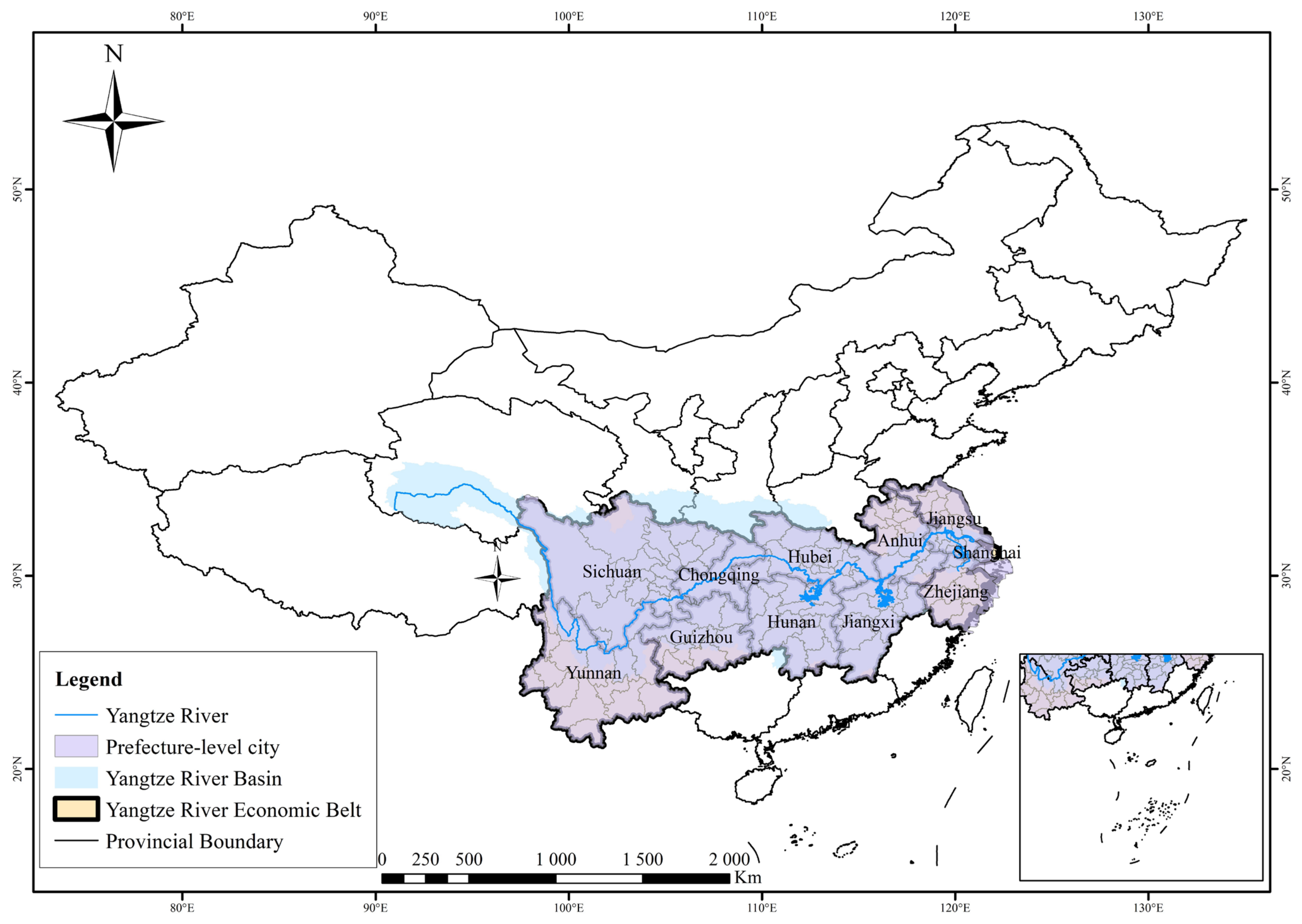
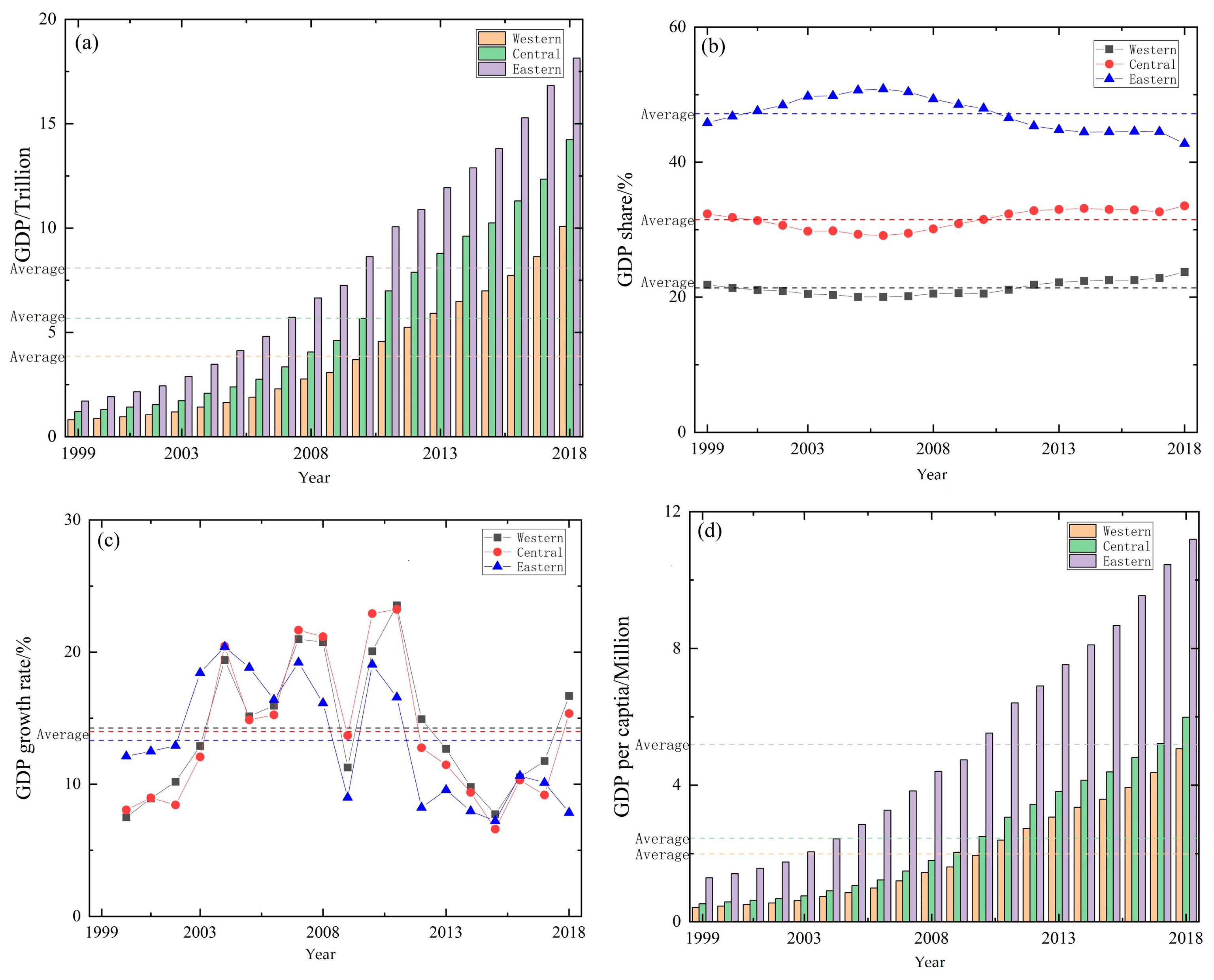
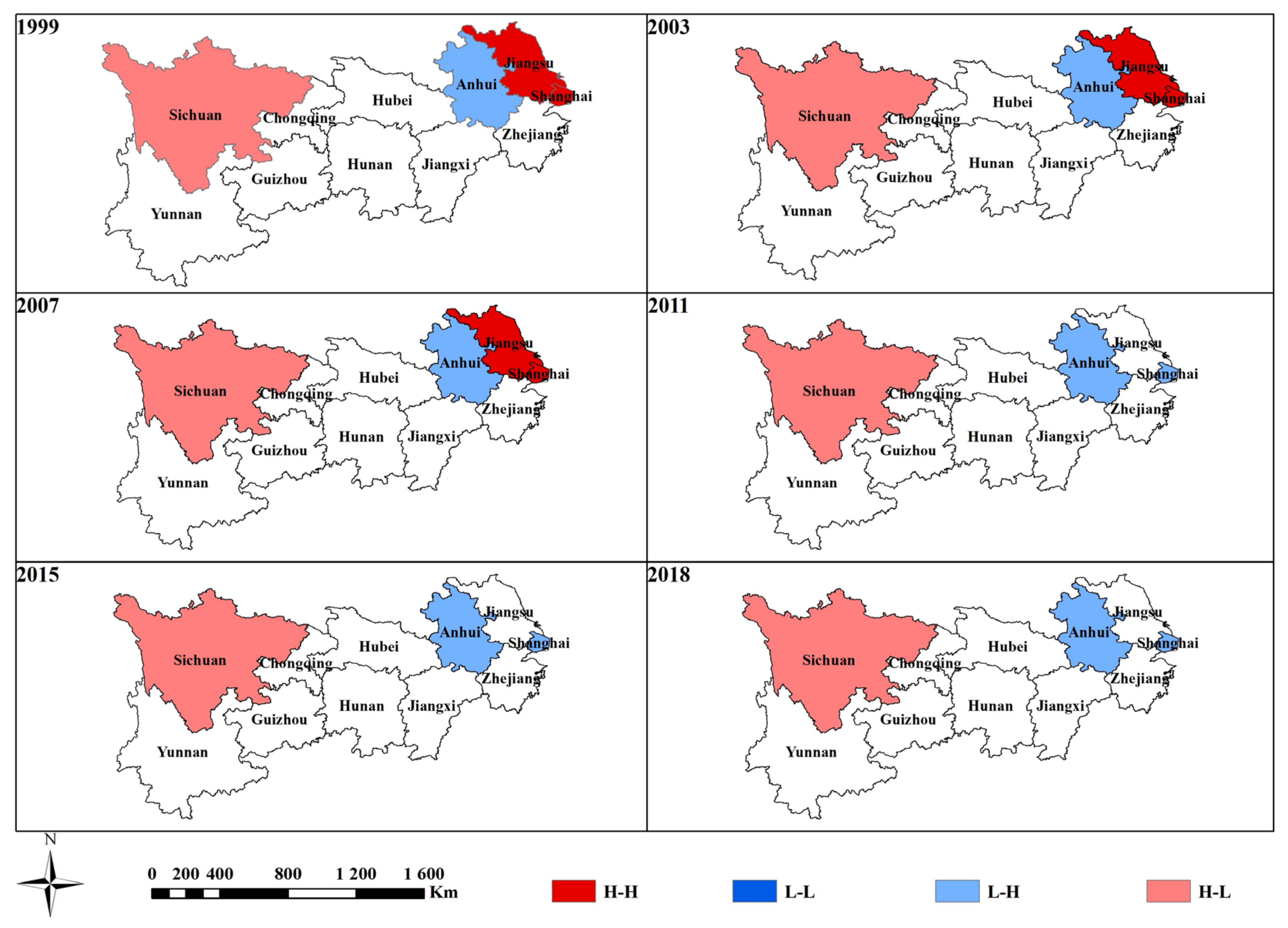
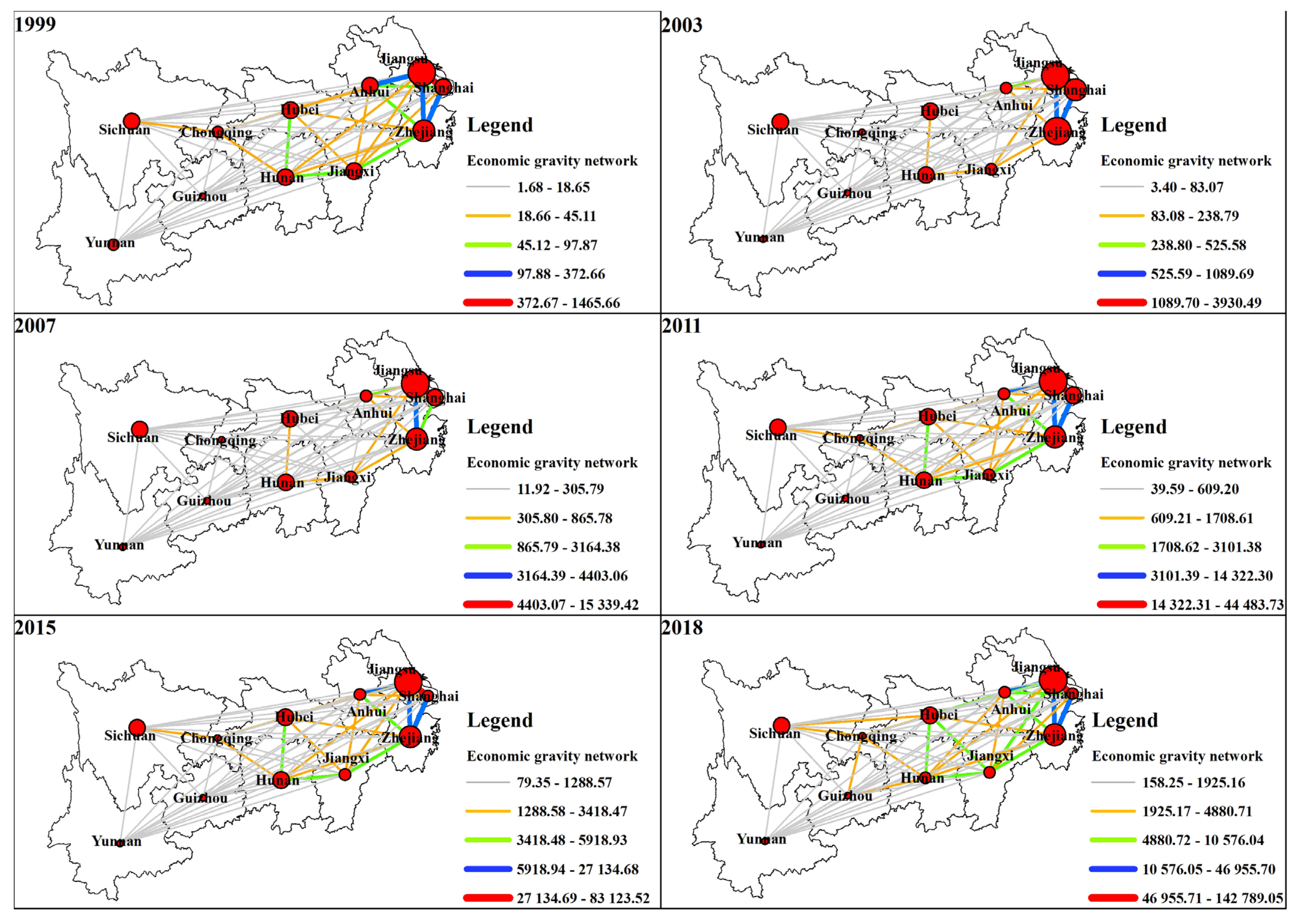
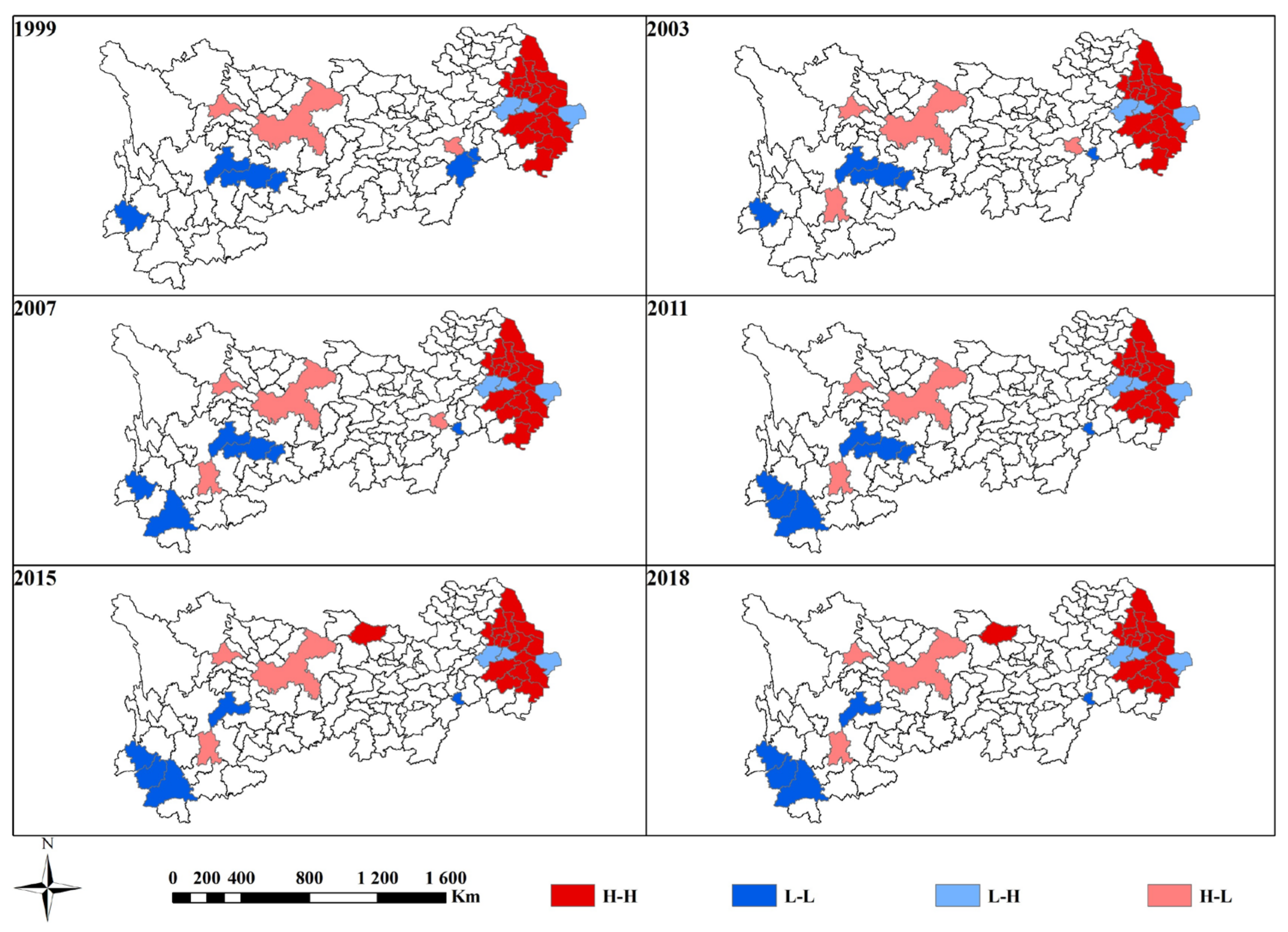
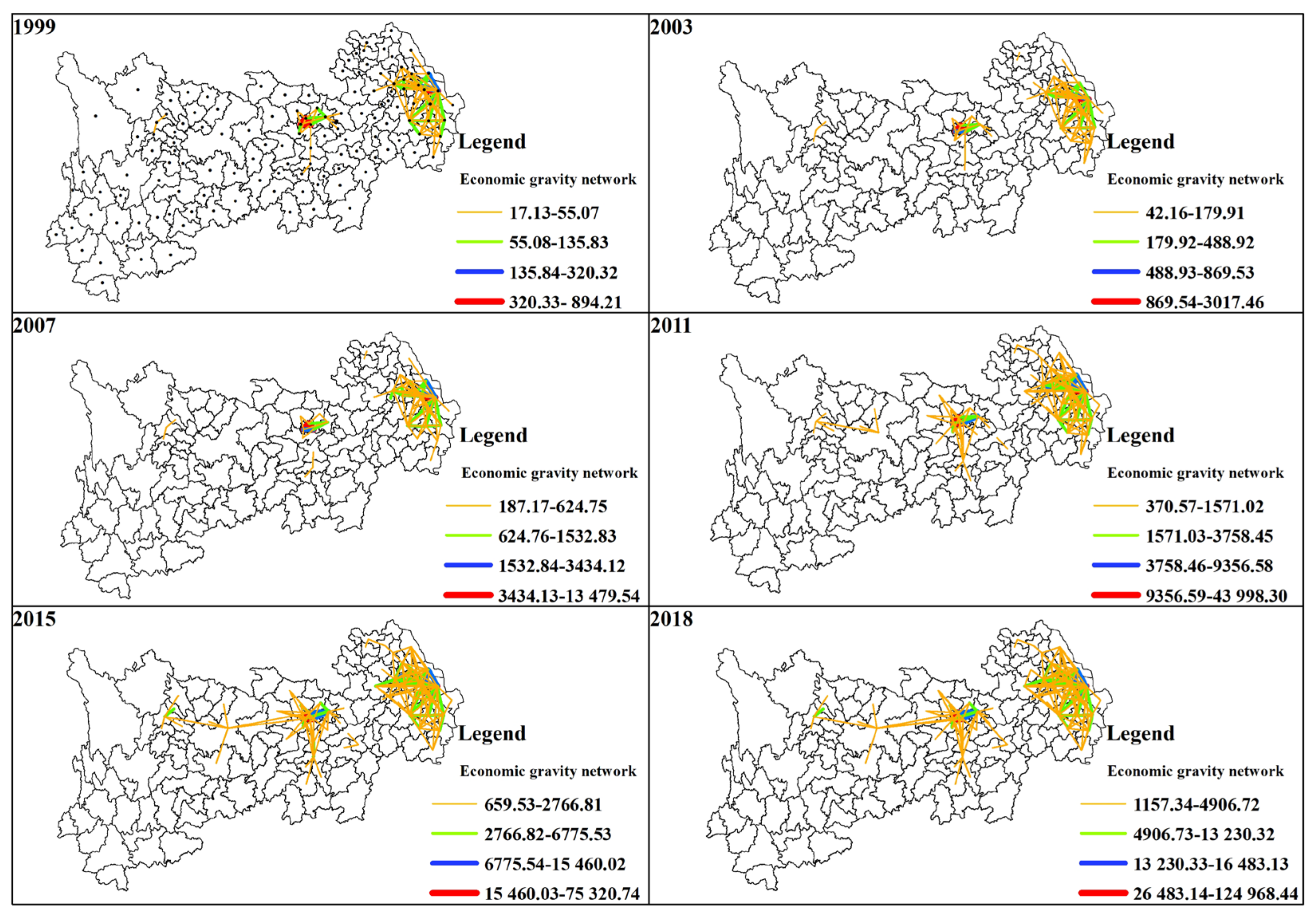
| Year | GDP/Trillion | Standard Deviation | Coefficient of Variation | Theil Index | Moran’s I | |
|---|---|---|---|---|---|---|
| Province | City | |||||
| 1999 | 3.73 | 0.187 | 0.551 | 0.130 | 0.341 | 0.131 |
| 2000 | 4.10 | 0.212 | 0.568 | 0.138 | 0.342 | 0.135 |
| 2001 | 4.53 | 0.238 | 0.577 | 0.142 | 0.365 | 0.134 |
| 2002 | 5.03 | 0.272 | 0.594 | 0.149 | 0.367 | 0.139 |
| 2003 | 5.80 | 0.327 | 0.620 | 0.161 | 0.373 | 0.152 |
| 2004 | 6.97 | 0.394 | 0.622 | 0.162 | 0.378 | 0.154 |
| 2005 | 8.15 | 0.485 | 0.654 | 0.175 | 0.344 | 0.159 |
| 2006 | 9.45 | 0.569 | 0.663 | 0.179 | 0.331 | 0.163 |
| 2007 | 11.37 | 0.678 | 0.656 | 0.175 | 0.318 | 0.162 |
| 2008 | 13.48 | 0.790 | 0.645 | 0.168 | 0.288 | 0.155 |
| 2009 | 14.94 | 0.866 | 0.638 | 0.165 | 0.269 | 0.149 |
| 2010 | 18.00 | 1.041 | 0.636 | 0.165 | 0.251 | 0.151 |
| 2011 | 21.62 | 1.213 | 0.617 | 0.155 | 0.221 | 0.144 |
| 2012 | 24.02 | 1.311 | 0.600 | 0.146 | 0.185 | 0.136 |
| 2013 | 26.63 | 1.432 | 0.592 | 0.141 | 0.170 | 0.131 |
| 2014 | 28.98 | 1.545 | 0.586 | 0.137 | 0.157 | 0.127 |
| 2015 | 31.05 | 1.657 | 0.587 | 0.136 | 0.150 | 0.124 |
| 2016 | 34.31 | 1.824 | 0.585 | 0.135 | 0.160 | 0.120 |
| 2017 | 37.80 | 2.016 | 0.587 | 0.135 | 0.152 | 0.121 |
| 2018 | 42.46 | 2.129 | 0.552 | 0.121 | 0.121 | 0.118 |
| Year | Theil Index | Decomposition | Contribution Rate | Intergroup | ||||
|---|---|---|---|---|---|---|---|---|
| Eastern | Central | Western | Eastern | Central | Western | |||
| 1999 | 0.130 | 0.035 | 0.003 | 0.114 | 0.123 | 0.006 | 0.191 | 0.680 |
| 2000 | 0.138 | 0.034 | 0.004 | 0.113 | 0.114 | 0.009 | 0.175 | 0.702 |
| 2001 | 0.142 | 0.029 | 0.004 | 0.113 | 0.098 | 0.008 | 0.167 | 0.727 |
| 2002 | 0.149 | 0.030 | 0.004 | 0.112 | 0.098 | 0.008 | 0.157 | 0.737 |
| 2003 | 0.161 | 0.030 | 0.004 | 0.111 | 0.094 | 0.008 | 0.141 | 0.757 |
| 2004 | 0.162 | 0.030 | 0.004 | 0.113 | 0.094 | 0.007 | 0.141 | 0.759 |
| 2005 | 0.175 | 0.039 | 0.005 | 0.112 | 0.113 | 0.009 | 0.128 | 0.750 |
| 2006 | 0.179 | 0.041 | 0.006 | 0.117 | 0.117 | 0.010 | 0.131 | 0.742 |
| 2007 | 0.175 | 0.042 | 0.007 | 0.117 | 0.122 | 0.012 | 0.134 | 0.731 |
| 2008 | 0.168 | 0.049 | 0.008 | 0.111 | 0.144 | 0.015 | 0.136 | 0.705 |
| 2009 | 0.165 | 0.055 | 0.008 | 0.116 | 0.161 | 0.015 | 0.144 | 0.680 |
| 2010 | 0.165 | 0.060 | 0.008 | 0.121 | 0.176 | 0.016 | 0.151 | 0.657 |
| 2011 | 0.155 | 0.068 | 0.008 | 0.118 | 0.203 | 0.016 | 0.161 | 0.620 |
| 2012 | 0.146 | 0.074 | 0.008 | 0.111 | 0.231 | 0.018 | 0.165 | 0.586 |
| 2013 | 0.141 | 0.077 | 0.008 | 0.101 | 0.247 | 0.018 | 0.159 | 0.575 |
| 2014 | 0.137 | 0.080 | 0.009 | 0.094 | 0.258 | 0.021 | 0.153 | 0.568 |
| 2015 | 0.136 | 0.081 | 0.010 | 0.084 | 0.266 | 0.024 | 0.139 | 0.571 |
| 2016 | 0.135 | 0.079 | 0.009 | 0.082 | 0.262 | 0.023 | 0.136 | 0.579 |
| 2017 | 0.135 | 0.083 | 0.008 | 0.082 | 0.273 | 0.019 | 0.138 | 0.570 |
| 2018 | 0.121 | 0.084 | 0.007 | 0.080 | 0.296 | 0.021 | 0.157 | 0.527 |
| Provinces | Items | 1999 | 2000 | 2001 | 2002 | 2003 | 2004 | 2005 | 2006 | 2007 | 2008 | 2009 | 2010 | 2011 | 2012 | 2013 | 2014 | 2015 | 2016 | 2017 | 2018 |
|---|---|---|---|---|---|---|---|---|---|---|---|---|---|---|---|---|---|---|---|---|---|
| Jiangsu | SD | 0.038 | 0.040 | 0.046 | 0.054 | 0.072 | 0.088 | 0.109 | 0.128 | 0.153 | 0.181 | 0.197 | 0.233 | 0.271 | 0.303 | 0.324 | 0.342 | 0.360 | 0.381 | 0.422 | 0.460 |
| COV | 0.668 | 0.625 | 0.644 | 0.674 | 0.745 | 0.751 | 0.753 | 0.755 | 0.753 | 0.752 | 0.733 | 0.715 | 0.705 | 0.699 | 0.675 | 0.656 | 0.642 | 0.630 | 0.624 | 0.634 | |
| Zhejiang | SD | 0.037 | 0.042 | 0.047 | 0.054 | 0.063 | 0.075 | 0.087 | 0.101 | 0.121 | 0.139 | 0.148 | 0.175 | 0.206 | 0.227 | 0.244 | 0.266 | 0.287 | 0.320 | 0.362 | 0.389 |
| COV | 0.676 | 0.681 | 0.696 | 0.695 | 0.697 | 0.695 | 0.709 | 0.710 | 0.711 | 0.714 | 0.716 | 0.713 | 0.713 | 0.722 | 0.715 | 0.723 | 0.735 | 0.743 | 0.767 | 0.759 | |
| Anhui | SD | 0.007 | 0.009 | 0.008 | 0.009 | 0.010 | 0.012 | 0.022 | 0.021 | 0.027 | 0.036 | 0.043 | 0.063 | 0.078 | 0.089 | 0.100 | 0.112 | 0.122 | 0.136 | 0.151 | 0.169 |
| COV | 0.429 | 0.524 | 0.446 | 0.454 | 0.468 | 0.454 | 0.646 | 0.566 | 0.594 | 0.663 | 0.701 | 0.791 | 0.796 | 0.811 | 0.818 | 0.840 | 0.865 | 0.880 | 0.883 | 0.891 | |
| Jiangxi | SD | 0.010 | 0.011 | 0.012 | 0.014 | 0.016 | 0.021 | 0.024 | 0.029 | 0.033 | 0.039 | 0.043 | 0.051 | 0.062 | 0.069 | 0.077 | 0.085 | 0.094 | 0.103 | 0.118 | 0.131 |
| COV | 0.642 | 0.642 | 0.652 | 0.657 | 0.651 | 0.670 | 0.672 | 0.672 | 0.650 | 0.632 | 0.619 | 0.592 | 0.588 | 0.586 | 0.592 | 0.595 | 0.611 | 0.610 | 0.644 | 0.653 | |
| Hubei | SD | 0.027 | 0.031 | 0.034 | 0.039 | 0.042 | 0.048 | 0.058 | 0.070 | 0.083 | 0.107 | 0.120 | 0.145 | 0.177 | 0.210 | 0.238 | 0.265 | 0.282 | 0.308 | 0.346 | 0.383 |
| COV | 0.929 | 1.075 | 1.093 | 1.358 | 1.099 | 1.110 | 1.220 | 1.256 | 1.259 | 1.291 | 1.270 | 1.255 | 1.210 | 1.232 | 1.240 | 1.249 | 1.175 | 1.179 | 1.194 | 1.216 | |
| Hunan | SD | 0.012 | 0.014 | 0.016 | 0.018 | 0.021 | 0.025 | 0.034 | 0.041 | 0.050 | 0.069 | 0.088 | 0.107 | 0.132 | 0.150 | 0.167 | 0.183 | 0.199 | 0.219 | 0.240 | 0.258 |
| COV | 0.465 | 0.515 | 0.534 | 0.547 | 0.575 | 0.583 | 0.688 | 0.708 | 0.708 | 0.793 | 0.865 | 0.864 | 0.863 | 0.860 | 0.866 | 0.862 | 0.865 | 0.870 | 0.909 | 0.906 | |
| Sichuan | SD | 0.025 | 0.028 | 0.032 | 0.036 | 0.040 | 0.046 | 0.050 | 0.058 | 0.070 | 0.082 | 0.095 | 0.118 | 0.148 | 0.173 | 0.194 | 0.215 | 0.230 | 0.261 | 0.299 | 0.331 |
| COV | 1.248 | 1.280 | 1.322 | 1.334 | 1.323 | 1.287 | 1.278 | 1.273 | 1.256 | 1.235 | 1.266 | 1.291 | 1.303 | 1.329 | 1.349 | 1.365 | 1.371 | 1.432 | 1.474 | 1.500 | |
| Guizhou | SD | 0.008 | 0.009 | 0.010 | 0.011 | 0.013 | 0.015 | 0.017 | 0.019 | 0.021 | 0.025 | 0.030 | 0.035 | 0.043 | 0.052 | 0.064 | 0.076 | 0.087 | 0.095 | 0.106 | 0.115 |
| COV | 0.643 | 0.659 | 0.678 | 0.680 | 0.672 | 0.654 | 0.618 | 0.604 | 0.582 | 0.568 | 0.579 | 0.571 | 0.574 | 0.567 | 0.582 | 0.579 | 0.571 | 0.565 | 0.562 | 0.569 | |
| Yunnan | SD | 0.019 | 0.020 | 0.021 | 0.023 | 0.026 | 0.030 | 0.034 | 0.038 | 0.045 | 0.051 | 0.058 | 0.067 | 0.079 | 0.094 | 0.106 | 0.114 | 0.121 | 0.131 | 0.149 | 0.159 |
| COV | 1.114 | 1.112 | 1.132 | 1.140 | 1.154 | 1.140 | 1.112 | 1.096 | 1.079 | 1.053 | 1.055 | 1.046 | 1.027 | 1.029 | 1.023 | 1.031 | 1.031 | 1.031 | 1.052 | 1.063 |
Disclaimer/Publisher’s Note: The statements, opinions and data contained in all publications are solely those of the individual author(s) and contributor(s) and not of MDPI and/or the editor(s). MDPI and/or the editor(s) disclaim responsibility for any injury to people or property resulting from any ideas, methods, instructions or products referred to in the content. |
© 2024 by the authors. Licensee MDPI, Basel, Switzerland. This article is an open access article distributed under the terms and conditions of the Creative Commons Attribution (CC BY) license (https://creativecommons.org/licenses/by/4.0/).
Share and Cite
Zhao, Z.; Cai, Y. Research on the Spatial Differences and Network Structure of Economic Development in the Yangtze River Belt, China. Sustainability 2024, 16, 5023. https://doi.org/10.3390/su16125023
Zhao Z, Cai Y. Research on the Spatial Differences and Network Structure of Economic Development in the Yangtze River Belt, China. Sustainability. 2024; 16(12):5023. https://doi.org/10.3390/su16125023
Chicago/Turabian StyleZhao, Ziyang, and Yihui Cai. 2024. "Research on the Spatial Differences and Network Structure of Economic Development in the Yangtze River Belt, China" Sustainability 16, no. 12: 5023. https://doi.org/10.3390/su16125023
APA StyleZhao, Z., & Cai, Y. (2024). Research on the Spatial Differences and Network Structure of Economic Development in the Yangtze River Belt, China. Sustainability, 16(12), 5023. https://doi.org/10.3390/su16125023





